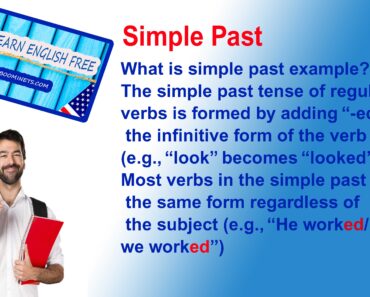
The simple present is a verb tense with two main uses. We use the simple present tense when an action is happening right now, or when it happens regularly (or unceasingly, which is why it’s sometimes called present indefinite). Depending on the person, the simple present tense is formed by using the root form or by adding s or es to the end.
How to form the simple present
In the simple present, most regular verbs use the root form, except in the third-person singular (which ends in s).
How to ask a question
The formula for asking a question in the simple present is do/does + [subject] + [root form of verb].
Do you know how to bake a pie?
Examples Used to Denote Habitual Actions
He goes to school every morning.
Sara watches cartoons every day.
Examples Used to Denote General Statements / Universal Truths
- Humans are mortals.
- Changing is nature’s law.
- Water is tasteless, colourless and odourless.
- Sun gives us light
Examples Used to Denote Repeated Events/Actions
- I watch movies on Saturday.
- Dalida comes by car to the office.
- The milkman delivers milk cartons every day.
- The garbage van comes after every two days.
Examples Used to Denote Directions or Instructions
- Go along this road.
- Go straight on/ahead. (Stay on this road – don’t turn.)
- Go through the tunnel.
- At the roundabout, take the first exit.
- Turn left at the crossroads.
- Take the second right.
How to Use the Simple Present Tense: A Comprehensive Guide

The simple present tense is a fundamental verb tense in English grammar. It has two primary uses: to describe actions happening right now and to express habitual actions or occurrences. In this guide, we will explore how to form the simple present tense, make it negative, ask questions, and provide examples to help you understand its usage better.
Forming the Simple Present Tense
In most cases, the simple present tense is formed by using the root form of the verb. However, when referring to the third-person singular (he/she/it), we usually add an ‘s’ or ‘es’ to the end of the verb. Let’s take a look at the different forms of the simple present tense:
| Person | Verb |
|---|---|
| First-person singular | I write |
| Second-person singular | You write |
| Third-person singular | He/she/it writes |
| First-person plural | We write |
| Second-person plural | You write |
| Third-person plural | They write |
Keep in mind that some verbs have irregular forms in the third-person singular. These verbs end in ‘o,’ ‘ch,’ ‘sh,’ ‘th,’ ‘ss,’ ‘gh,’ or ‘z,’ and their third-person singular form ends with ‘es.’ For example:
| Person | Verb |
|---|---|
| First-person singular | I go |
| Second-person singular | You go |
| Third-person singular | He/she/it goes |
| First-person plural | We go |
| Second-person plural | You go |
| Third-person plural | They go |
When using most regular verbs in the negative form, we place the negation before the verb. For instance, “She won’t go” or “I don’t smell anything.” However, remember that the verb “to be” is irregular:
| Person | Verb |
|---|---|
| First-person singular | I am |
| Second-person singular | You are |
| Third-person singular | He/she/it is |
| First-person plural | We are |
| Second-person plural | You are |
| Third-person plural | They are |
Making the Simple Present Tense Negative
To form the negative form of the simple present tense, we use the formula “do/does + not + [root form of the verb].” Alternatively, we can use the contractions “don’t” or “doesn’t” instead of “do not” or “does not.” For example:
- I do not ask questions.
- He does not work here.
- They do not use that tool.
When it comes to the verb “to be,” the negative form is created by using “[to be] + not.” Consider the following examples:
- I am not a doctor.
- She is not happy.
- They are not at home.
Asking Questions in the Simple Present Tense
To ask a question in the simple present tense, we use the formula “do/does + [subject] + [root form of the verb].” Here are a few examples:
- Do you ask questions?
- Does she work here?
- Do they use that tool?
It is essential to note that when asking questions with the verb “to be,” we invert the subject and the verb, without using “do/does.” For instance:
- Are you a doctor?
- Is she happy?
- Are they at home?
Common Verbs in the Simple Present Tense
There are numerous common verbs used in the simple present tense. Let’s explore some examples:
| Infinitive | I, You, We, They | He, She, It |
|---|---|---|
| to ask | ask / do not ask | asks / does not ask |
| to work | work / do not work | works / does not work |
| to call | call / do not call | calls / does not call |
| to use | use / do not use | uses / does not use |
| to have | have / do not have | has / does not have |
It is worth noting that these examples are in the affirmative form. To create negative and interrogative forms, refer back to the previous sections.
Examples of the Simple Present Tense
To provide a better understanding of how to use the simple present tense, let’s explore a few examples:
- Affirmative:
- I eat breakfast every morning.
- She reads books in her free time.
- They play soccer on weekends.
- Negative:
- I do not eat fast food.
- She does not watch television.
- They do not like spicy food.
- Interrogative:
- Do you eat vegetables?
- Does she enjoy hiking?
- Do they live in a big city?
Remember to adjust the verb form based on the subject and whether the sentence is in the affirmative, negative, or interrogative form.
Conclusion
The simple present tense is a versatile verb tense that allows us to describe actions happening right now and express habitual actions or occurrences. By understanding how to form the simple present tense, make it negative, and ask questions, you can effectively communicate in various situations. Practice using the simple present tense in your writing and conversations to become more fluent in English.





